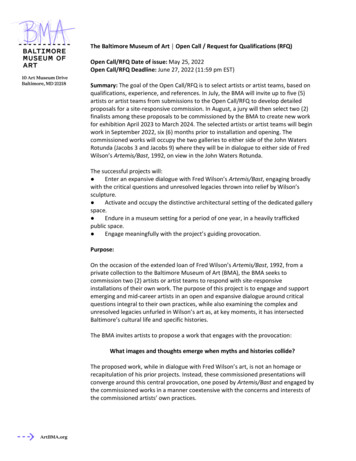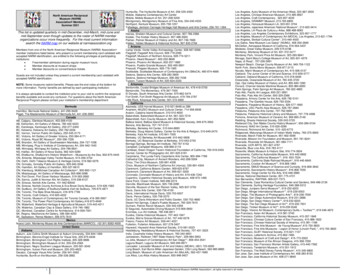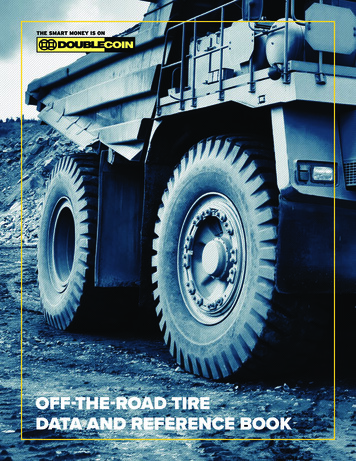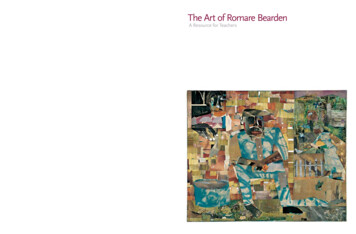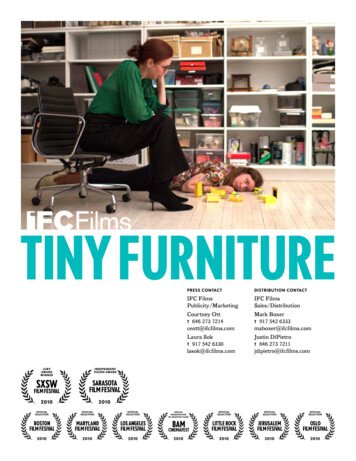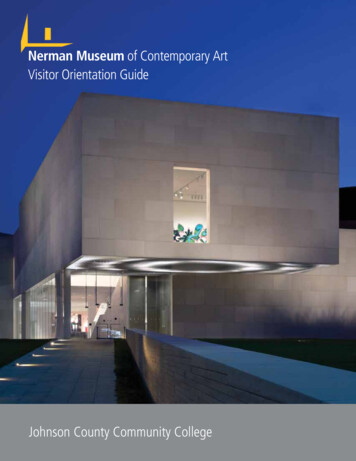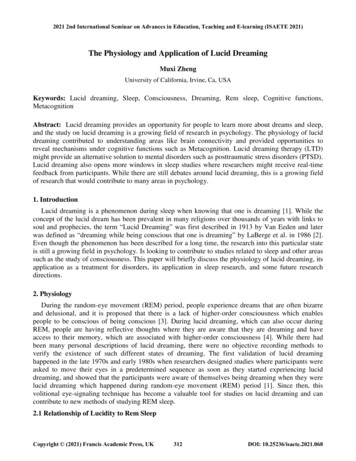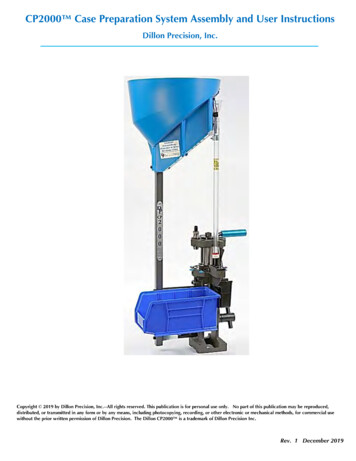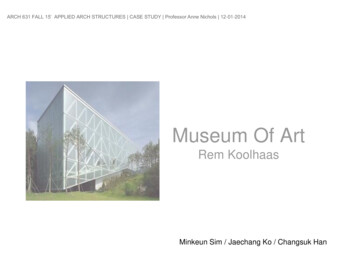
Transcription
ARCH 631 FALL 15’ APPLIED ARCH STRUCTURES CASE STUDY Professor Anne Nichols 12-01-2014Museum Of ArtRem KoolhaasMinkeun Sim / Jaechang Ko / Changsuk Han
INTRODUCTIONSTRUCTURE FEATURESFOUNDATION SYSTEMLOADING ANALYSISLATERAL LOAD BEHAVIORMATERIALS
PART 1 INTRODUCTION- General Information- Design Concept- Building Layout
General Information
General InformationLocation: Seoul National University, Seoul, South KoreaCompleted: 2005Floor count: Ground 3 story & Basement 3 storyFloor area: 4,486.47 m2Building area: 2,775.56 m2Building height: 17.575 MArchitect: Rem KoolhaasEngineer: Samsung Engineering
General InformationSeoulThe Site- Seoul National University, Seoul, SouthKoreaSouth KoreaSeoul NationalUniversity
General InformationThe Site- Seoul National University, Seoul, SouthKoreaSNU MOA
Site AnalysisClimate- Part of the East Asianmonsoonal region- Four distinct seasons- Winter: long, cold, anddry (Avg. 23 )- Summer: short, hot, andhumid (Avg. 77 )- Spring & Autumn:pleasant and short
Site AnalysisEarthquake- The occurrence of earthquake during 30 years(1981 - 2012)- Non-strong earthquake- Low dangerousness of earthquakes- Seismic forces can be considered less thanother lateral forces on the site.
Site AnalysisSeasonal Wind Loads- Wind directions- Wind Speeds- Dynamic Changes
Site AnalysisWind Load (Seoul)- Seasonal WindAnalysis- Southwester (summer)- Strong Northwester(winter)- Strong Northeaster(autumn)- High consideration oflateral loading forstructural design.
Site AnalysisSoil Condition- Boring tests were required on threepoints (BH-1. BH-2. BH-3) of slopesto check soil condition.- BH-3: Manager Offices, StoragesArea- BH-2: Vertical core that supportcantilevers of both sides.TypesDepthBurried layer0 1.8mAlluvium1.8 8.8mWeatheredrock8.8 10.3mSoft rock10.3 12mburried layeralluviumweathered rocksoft rock
EarthworksPART ‘A’-Back filling after placing B1 floor slab concretePART ‘B’-Back filling, soil stabilizationand then, placing mat foundation
Earthworks ProcessExcavationInstalling wood lagging 2Driving H-pileDriving pipes for drainageInstalling wood lagging 1Earth-anchor system
Design ConceptThe design concept of the Seoul National University Museum is toconnect the university with the local community.
Design ConceptDesign Process
Building LayoutMOA’s program
Third Floor PlanExhibition Room with partitionsExhibition Room
No walls and no columns inside. It allows to provide diverse exhibition spaces and display plans by using partitions.
Second Floor PlanAuditorium
Auditorium
The special structures provide longspan space for the auditorium.Thus, audiences can enjoy lecturesor performances withoutinterruptions of structures.
Ground Floor PlanAuditoriumMain Entry Square
Auditorium
Main Entry SquareThe mass restructured inthis way is floating in the air,supported by its concretecore and cantilevered steelframe. It has the specialbuilding’sfeatureandprovides the spectacularentry square.
Basement LevelSub Entry Square
SectionVertical Core & Structural Wall
Vertical Core (stairs)Core Structural Wall
PART 2 STRUCTURE FEATURES- Structure Component- Structure Principle- Structure Progress
Structure Component-Steel Frame TrussesReinforced Concrete
Structure Principle
Structure Principle
Load Analysis
Truss Slaves-Replace Simple Truss with Plate GirderImproving workabilityPlate Girder makes simple progress aswell as reduce welding in constructionarea
Structure Component-Example
Foundation Type - Mat Foundation--Shallow foundation.Mat foundations are used to distribute heavycolumn and wall loads across the entire buildingarea, to lower the contact pressure compared toconventional spread footings.It can be constructed near the ground surface, orat the bottom of basements.In high-rise buildings, mat foundations can beseveral meters thick, with extensive reinforcing toensure relatively uniform load transfer.
Structure Component-Steel Frame TrussesReinforced Concrete
Structure ProgressInside - outsideCoreInterior courtPerimeter ZoneOutside
Structure ProgressInterior courtCorePerimeter ZoneOutside
Structure ProgressBent Jack-Down Construction ProcedureStructure InspectionPieces Conveyance-Installation membersJack up (A: 25mm /G: 40mm)Measure dimension after jack downConcrete PlacementMeasure dimensionRemove supportsLevel upMeasure dimension
Structure ProgressSupportFloor GirderTransfer GirderCantilever TrussFloor GirderTransfer GirderWeldingCompletion
PART 3 LOADING ANALYSIS- Gravity Loads- Lateral Loads- Multi-frame Analysis
Multi-frame Analysis: Gravity LoadsSnow Load : S P Zs Cs (Seoul ; 50 kgf/m2Live Load : Office, Public space : 500kgf/m 2Dead Load : CON STEEL Slab 1cm thick 80kg/m 225cm 2500kg/m 260.6 * 23 1393.8m 21393.8 * 2500 3,484,500kg 3,484.5 ton2story rooftop 10,453 ton
Multi-frame Analysis: Gravity Loads
Multi-frame Analysis: Gravity Loads
Multi-frame Analysis: Gravity Loads
Multi-frame Analysis: Gravity Loads
Multi-frame Analysis: Gravity Loads
Multi-frame Analysis: Gravity Loads
Multi-frame Analysis: Lateral Loads (Wind)Wind Load :Average : 2.5m/sMaximum : Hurricane ‘Maemi’ 60m/s
Multi-frame Analysis: Lateral Loads (Wind)
Multi-frame Analysis: Lateral Loads (Wind)
PART 4 LATERAL LOAD BEHAVIOR- Wind Load Behavior- Seismic Load Behavior
Multi-frame Analysis: Wind Load Behavior
Multi-frame Analysis: Seismic Load BehaviorSeismic :Maximum limit law : 5In this caseMaximum Richter : 9
PART 5 Materials- Exterior Materials- Interior Materials
Exterior MaterialsU-profiled glass--During installing U-Glass, use twocranes(for AL. Frame, for U-Glass)for upper parts and use one cranefor down partsInstall from up to down, North toSouth
Exterior MaterialsU-profiled glass-Higher thermal efficiency than double glazingHigh light scattering efficiency - good lighting effects
Exterior MaterialsAL. Panel--Use AL. Panel instead of outsideinsulation systemprotect from outside air through paintingfilm.Installing AL.Panel on outside of corewall, lower parts of cantilever, exposedslab and parapet.DABCABCD
Interior MaterialsDanpalon Panel-Double Panel System: High Insulation,soundproof, anti-sweatingprovide good interior and duct spaces.light weight materials: lower building load
Connection DescriptionDanpalon--Danpalon can diffuse artificial lighting that seemsto luminous materialsThrough visual effect, interior spaces look likewider spaces.
Citations of bibliographic sourcesVideo : https://www.youtube.com/watch?v phKDiZM9R48Drawing : seul-moa.htmlImage & Diagram : l-university-museum-by-oma.html?view flipcard&m 1Photoes : http://www.spaceinvading.com/entry/project id/Seoul National University tos/guen ias/docs/portfolio aad (p.85)Book:Koolhaas, R. (2007). Seoul National University Museum of Art 2005. In AMOMA Rem Koolhaas II: 1996/2007 : Teoría y práctica theory andpractice. (1st ed., pp. 278-303). Madrid: El Croquis.
THANK YOU
Location: Seoul National University, Seoul, South Korea Completed: 2005 Floor count: Ground 3 story & Basement 3 story 2 2 Building height: 17.575 M Architect: Rem Koolhaas Engineer: Samsung Engineering . General Information The Site - Seoul National University, Seoul, South Korea Seoul National University South Korea
